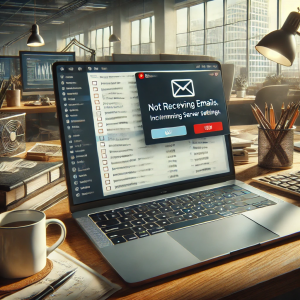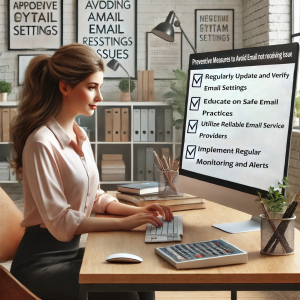Emails Not Receiving
In our digitally driven world, email stands as a cornerstone of communication, whether for personal connections, professional correspondence, or crucial business transactions. Its ability to bridge vast distances in mere seconds not only facilitates efficiency but also fosters opportunities across global landscapes. Yet, when email systems falter, the effects can ripple through our day-to-day activities, causing disruptions that range from minor annoyances to significant setbacks.
Many users face the frustrating challenge of discovering that they cannot receive emails. This issue can manifest in various ways—some might find that they are specifically not receiving emails from one person, while others might realize they are unable to receive emails entirely. This problem can isolate individuals from critical updates, lead to missed opportunities, and disrupt both personal and professional life. For businesses, the inability to receive client communications due to emails not being received can result in lost revenue and damaged relationships.
Recognizing the pivotal role email plays in our lives, this blog aims to unravel the common issues and solutions associated with not getting emails. Whether you are dealing with an overloaded inbox, incorrect settings, or a miscommunication issue, understanding the main causes and knowing how to address them can restore your connectivity and ensure that you remain integrated in your digital communications sphere. Our comprehensive blog will navigate through the Email Not Receiving problem, equipping you with both basic and advanced troubleshooting strategies, along with preventive measures to avoid future disruptions.
By the end of this blog, you will be better prepared to tackle the challenges associated with not receiving emails, ensuring that your digital communications flow smoothly and uninterruptedly. Whether the issue lies with server settings, spam filters, or something as simple as a typo in an email address, our targeted advice will help you swiftly and effectively regain control of your inbox.
Common Reasons for Not Getting Emails
In today’s digital age, the issue of not getting emails can cause significant disruptions. Whether you’re unable to receive emails entirely or just not receiving emails from one person, several factors can contribute to this frustrating issue. By delving into the common reasons behind emails not being received, we can better understand and address these challenges effectively.
-
Email Account Configuration Issues:
A primary reason many find themselves not getting emails is due to incorrect email settings. Misconfigured server settings, such as the wrong server names, port numbers, or security protocols, can prevent your email client from receiving messages correctly. Additionally, overly strict email filters and sorting rules can misdirect incoming emails away from your inbox, filtering out important messages as spam or routing them to other folders.

-
Service Provider Issues:
Service-related issues are another critical area where you might find yourself unable to receive emails. Server downtime or maintenance by your email service provider can interrupt email delivery temporarily, leading to periods where emails not being received accumulate until service is restored. Moreover, IP blacklisting—a preventative measure against spam—can block incoming emails from specific sources, which might include legitimate senders if their IPs were previously used for spam. Staying informed about your provider’s maintenance schedule and understanding their spam prevention policies will help mitigate these issues.
-
Sender Issues:
On the sender’s side, common problems include using an incorrect email address or sending attachments that are too large. These mistakes can lead to delivery failures, which contribute to why you’re not receiving emails from one person or a group. Senders must ensure that the email addresses they use are accurate and that their attachments comply with size limits set by the recipient’s email server.
-
Security and Compliance Issues:
Security measures such as spam filters are notorious for catching and quarantining legitimate emails alongside genuine threats. This overzealous filtering can be why you’re not getting emails you’re expecting. Similarly, compliance blocks, particularly under regulations like GDPR, can prevent emails from being delivered if they don’t adhere to certain standards or protocols. Adjusting your spam filter settings and understanding compliance requirements are key steps in ensuring that Email Not Receiving issue is minimized.
Each of these reasons can independently or collectively be why you’re experiencing problems with not getting emails. Addressing them requires a nuanced understanding of how email systems work and how they interact with various settings and external factors. By tackling these common pitfalls, you can enhance your ability to receive emails reliably and efficiently.
Basic Steps to Troubleshoot Emails not receiving Issue
When you find yourself not getting emails, the frustration can be overwhelming. Whether you’re experiencing general issues like cannot receive emails or more specific problems such as emails not being received from particular senders, these basic troubleshooting steps are designed to help you pinpoint and solve the most common email reception issues effectively.
-
Check Spam or Junk Folder:
A common reason you might think you’re unable to receive emails is that they are being diverted to your spam or junk folder. To check this, navigate to your email client’s spam or junk folder and look for any legitimate messages that have been incorrectly classified. Pay attention to repeated senders in this folder; this can indicate which sender settings may need adjusting to prevent future misplacements.
-
Review Email Filter and Sorting Settings:
If you’re concerned about why you’re not getting emails as expected, reviewing your email filter and sorting settings is crucial. Access these settings through your email client’s settings or options menu. Look for any rules that might automatically redirect incoming emails away from your inbox. Adjust or remove filters that could be too restrictive and causing legitimate emails to be sorted incorrectly. This step is vital to ensure that you’re not missing out on important communications due to overly aggressive filtering.
-
Verify Email Address and Contact Details:
One simple yet often overlooked issue is incorrect email addresses. Ensure that the email addresses you expect communications from are correct in your contacts. Ask senders to confirm the email address they are using for you, especially if you’re not receiving emails from one person. Even a minor typo can result in email delivery failures, so verifying these details can quickly resolve the issue of Email Not Receiving.
-
Test with Alternate Email Addresses:
If after checking the above you are still unable to receive emails, try sending test emails to and from different email addresses. This can help determine if the problem is with your email account specifically or with certain senders. Send a check email to your own address from another account and vice versa. If emails from a specific sender consistently fail to arrive, but others succeed, it could indicate a sender-specific issue, such as being blocked or marked as spam at their end.
By systematically following these basic troubleshooting steps, you can effectively diagnose and often resolve many common issues related to Email Not Receiving. These steps are designed to ensure you regain control over your email communications and minimize disruptions caused by emails not being received.
Advanced Steps to Troubleshoot Emails Not Receiving Issue
For those who frequently find themselves saying that they cannot receive emails, delving into more advanced troubleshooting techniques may be necessary. These steps can help uncover deeper issues that aren’t resolved by basic troubleshooting and ensure you restore your email functionality.
-
Check Email Server Status:
One of the first advanced steps to take when you’re unable to receive emails is to check your email server’s status. This is especially relevant if you suspect the email service might be down. Most email service providers offer a status page or a support hotline where they report any ongoing outages or maintenance work. Checking these resources can quickly tell you if there’s a broader issue affecting your incoming server settings or IMAP server settings, which could be why you’re experiencing Email Not Receiving
-
Inspect Email Quota Limits:
Another critical area to inspect is your email quota limits. If your inbox is full, new messages cannot be delivered, which might be why you’re not getting emails. To check this, log into your email account and look for a storage indicator, often found in the settings or account overview section. If you are near or at your capacity, consider archiving old emails or increasing your storage limit to ensure you can continue to receive new emails without disruption.
-
Analyze Email Headers for Clues:
When specific emails fail to arrive, and you’re not receiving emails from one person, analyzing the email headers from messages sent by the same sender can provide valuable clues. Email headers contain detailed information about the path an email has taken from sender to recipient, along with any errors encountered along the way. To view these, you may need to select an option like “View Source” or “Show Original” in your email client. Look for discrepancies in the IMAP settings or other anomalies that could explain the delivery issues.
-
Consult IT Support or Email Service Provider:
If the aforementioned steps do not resolve the issue, it may be time to consult with IT support or your email service provider. This is particularly important if you’re dealing with complex IMAP server settings or if your email account is experiencing issues that go beyond basic user-level fixes. Provide them with all relevant information, including tests you’ve conducted, changes you’ve noticed, and any specific error messages you’ve encountered. Professional support can often quickly diagnose and resolve issues related to incoming server settings and other technical problems.
These advanced troubleshooting techniques provide a deeper dive into solving complex issues related to not getting emails. By methodically working through these instructions, you can address and rectify the more technical aspects of email reception problems, ensuring that your communications remain fluid and uninterrupted.
Preventive Measures to Avoid Email Not Receiving Issue
Ensuring the continuous and smooth receipt of emails requires not just reactive measures but proactive ones as well. By implementing the following preventive measures, you can significantly reduce the likelihood of experiencing problems where you cannot receive emails or find yourself repeatedly stating that you are not getting emails. Here’s how to safeguard your email communication against common disruptions.
-
Regularly Update and Verify Email Settings:
One of the most effective ways to avoid issues such as Email Not Receiving is to regularly update and verify your email settings. Keeping your IMAP settings, incoming server settings, and IMAP server settings up-to-date ensures compatibility with evolving email technologies and security standards. Periodically check that all email addresses are correctly configured and that server addresses, ports, and authentication methods are set correctly. This will help avoid problems where emails not being received are due to outdated or incorrect configurations.

-
Educate on Safe Email Practices:
Education on safe email practices is crucial in preventing emails from being lost or filtered out. Teach users to avoid common triggers for spam filters, like using all caps or excessive links and attachments in emails. Understanding the basics of email compliance, especially in regulated industries, can prevent situations where you’re unable to receive emails because they’ve been blocked for non-compliance. Regular training sessions on these topics can assist individuals and organizations ensure that their email practices don’t inadvertently lead to communication breakdowns.
-
Utilize Reliable Email Service Providers:
Choosing a reliable email service provider is critical in minimizing issues related to not receiving emails from one person or groups. Search for providers that offer strong uptime guarantees, robust security measures, and excellent customer support. These features can make a great difference in how effectively and reliably your email service functions, reducing the risk of emails not being received due to technical faults or service interruptions.
-
Implement Regular Monitoring and Alerts:
To further enhance your capability to maintain uninterrupted email service, implement regular monitoring and alerts for your email system’s health. Tools that monitor incoming server settings and alert you to anomalies in real-time can be invaluable. They allow you to address potential issues before they escalate into full-blown problems where you are not getting emails. Regular system checks can detect unusual patterns such as sudden increases in undelivered messages or unexpected changes in email volume that might indicate an issue.
By adopting these preventive measures, you can significantly decrease the frequency and impact of issues where you cannot receive emails. Regular updates, education on safe practices, choosing reliable service providers, and proactive system monitoring create a robust defense against the variety of issues that can disrupt email communication.
FAQs
Q1. What should I do if I cannot receive emails at all?
- A. Check your spam or junk folders first to ensure emails aren’t being incorrectly filtered. Then, review your email settings, especially incoming server settings and IMAP settings, to ensure they are correct according to your email provider’s requirements.
Q2. Why might I be unable to receive emails from a specific sender?
- A. If you’re not receiving emails from one person, it could be due to incorrect email addresses or your spam filters catching their emails. Verify the sender’s email address and check your spam filters and sorting rules.
Q3. What are common signs that my IMAP settings might be misconfigured?
- A. Common signs include Email Not Receiving messages consistently, especially when you can receive emails on one device but not another. Ensure that your IMAP server settings are configured correctly across all devices.
Q4. How can I troubleshoot if my email account is not getting emails due to server issues?
- A. Check the status of your email service provider to see if there have been any reported maintenance or outages which could be affecting your ability to receive emails. This information is typically available on the provider’s website or through their customer support.
Q5. What steps should I take if I am receiving an error that my inbox is full?
- A. If you’re informed that your mailbox is full, try deleting or archiving old emails to free up space. Checking your email quota directly in your account settings will let you know if you need to manage your storage.
Q6. How do changes in incoming server settings affect email reception?
- A. Incorrect incoming server settings can prevent your email client from connecting to your email server, resulting in issues where you cannot receive emails. Ensure these settings are updated whenever your email provider changes its requirements.
Q7. Can emails not being received be a sign of IP blacklisting?
- A. Yes, if your IP address has been blacklisted, it may prevent you from receiving emails from certain servers. Contact your ISP or email service provider if you suspect blacklisting is an issue.
Q8. Why do I need to regularly update my IMAP server settings?
- A. Regular updates to your IMAP server settings ensure compatibility with your email provider’s current configurations, helping to prevent problems where you are unable to receive emails.
Q9. What preventive measures can I take to ensure I am not missing critical emails?
- A. Regularly updating and verifying your email settings, educating yourself on safe email practices, using reliable email service providers, and implementing regular monitoring are key strategies to avoid Email Not Receiving issues.
Q10. What should I do if troubleshooting steps don’t resolve my not getting emails issue?
- A. If basic and advanced troubleshooting steps do not resolve the issue, it’s advisable to consult IT support or contact your email service provider for professional assistance, especially regarding specific configurations like IMAP server settings.
Conclusion
The ability to receive emails reliably is foundational to maintaining effective communication in today’s digitally interconnected world. When you discover that you cannot receive emails, it can lead to significant disruptions in both personal and professional realms. Throughout this blog, we have explored various reasons why you might find yourself saying that you are not getting emails and provided a comprehensive toolkit to address and resolve these issues.
By understanding the common causes, such as misconfigured incoming server settings or overly aggressive spam filters, and applying the basic to advanced troubleshooting steps discussed, you can often remedy situations where emails not being received have become a frequent frustration. Moreover, the importance of regularly updating IMAP settings and IMAP server settings, and ensuring that all configurations align with the latest standards, cannot be overstated. These practices are vital in preventing issues from recurring and ensuring that your email communication remains seamless.
We encourage you to utilize this guide not only as a reactive measure when problems arise but also proactively, to educate yourself and others on the intricacies of email systems and the best practices for maintaining them. Regular reviews of your email setup and adopting preventive measures can significantly decrease the likelihood of encountering problems where you are unable to receive emails.
Whether you’re not receiving emails from one person or experiencing broader issues with your email system, remember that timely intervention is key. The quicker you address these problems, the less impact they will have on your daily activities. Use this guide as a resource to navigate the complexities of email reception issues, troubleshoot effectively, and establish more robust defenses against future disruptions. By doing so, you can ensure that your communication channels remain open, reliable, and effective, allowing you to stay connected in an ever-evolving digital landscape.
To know about our support services, go to our Homepage.

